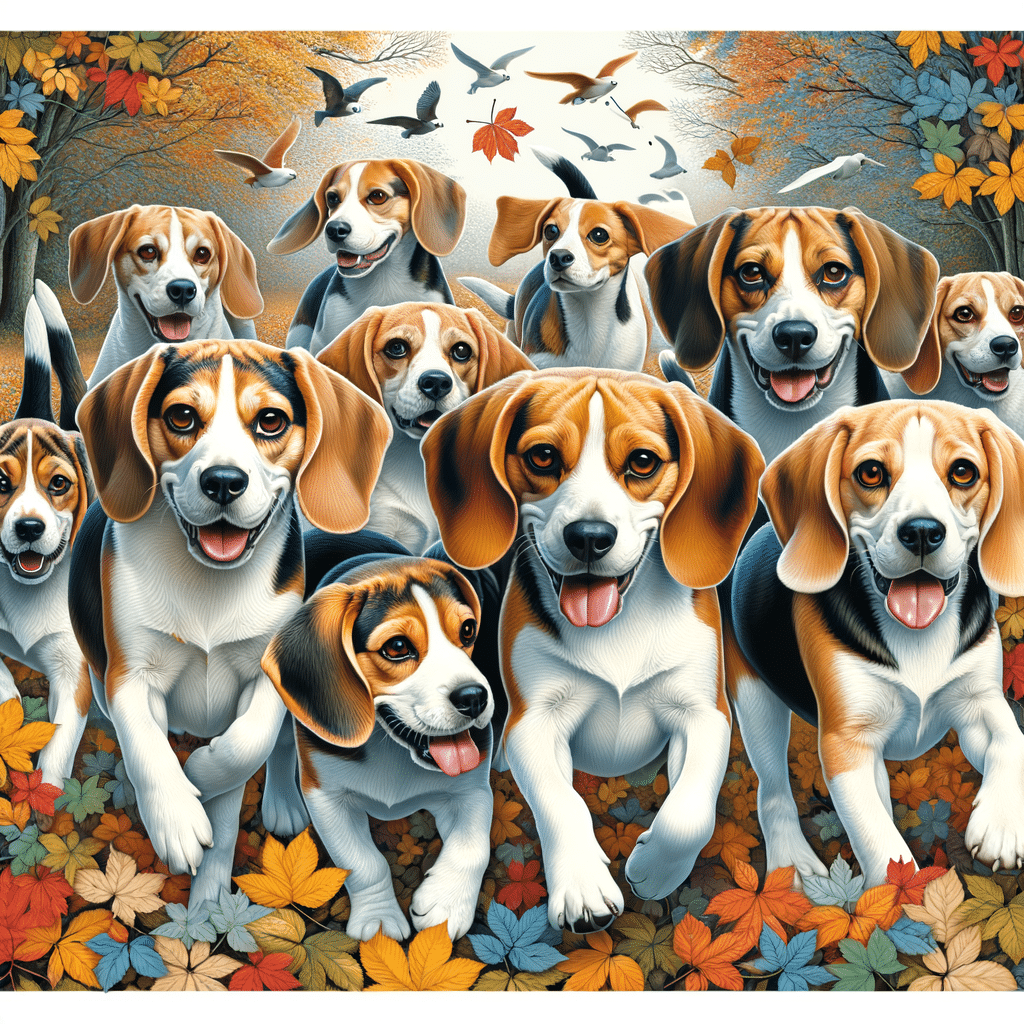Disciplining a beagle requires patience and an understanding of their specific behavior patterns. Beagles are lively and intelligent dogs but may show undesirable behaviors such as excessive barking or chewing.
In This Article
Effective discipline is not about knowing how to punish beagle dogs but about teaching your dog to associate positive outcomes with good behavior. It’s also about showing your dog that negative behaviors do not get them the attention they want.
Consistency and timing are crucial. Disciplining your beagle at the time of the unwanted behavior is more effective than delayed reactions, allowing your pet to make a clear connection between actions and consequences.
The best beagle training techniques use positive reinforcement, where rewarding your dog for good behavior encourages them to repeat the desired behavior. Avoid ineffective and harsh punishments, as these can cause fear, anxiety, and even aggression.
Instead, focus on constructive methods, such as redirecting the beagle’s energy to appropriate activities and ignoring them when they engage in attention-seeking behavior. This approach strengthens the bond between you and your dog and allows your pet to grow as a happy, well-behaved companion.
Highlights
- Consistent and timely guidance is essential for effective beagle discipline.
- Positive reinforcement is vital to promoting desired behaviors in beagles.
- Avoid harsh punishments to prevent negative psychological effects.
Understanding Beagle Behavior and Discipline
Effective beagle discipline requires recognizing this dog breed’s unique behavioral traits and encouraging positive behaviors. These dogs often display a blend of eagerness to please and stubbornness, requiring a balanced approach to discipline.
Importance of Consistency in Training
Beagles respond best to consistent training methods, as inconsistency can lead to confusion and reinforce negative behaviors. Start the training early, ideally between 8 and 12 weeks old, when your pet is most receptive. A routine reinforces what is expected of them, providing clear communication through consistent commands, rewards, and consequences for undesirable behavior.
Key Components for Consistency
- Commands: Use the same words for each action.
- Routine: Establish a regular schedule for feeding, walks, and training.
- Discipline: Apply the same consequences for bad behavior immediately after it occurs.
Utilizing Positive Reinforcement
Positive reinforcement is important in disciplining beagles. They are highly food-motivated and respond well to treats and praise when they show good behavior. This method increases your pup’s desire to obey while creating a trusting and loving relationship between you and your dog.
Strategies for Positive Reinforcement:
- Rewards: Offer treats, attention, and verbal praise to reinforce good behaviors.
- Attention: Dedicate time to interact with your beagle when they follow commands.
- Non-verbal signals: Use body language to communicate approval or disapproval, as beagles are good at reading such cues.
Effective Training Techniques
Training a beagle requires a structured approach, using rewards to encourage positive behavior. The focus should be on teaching the dog by providing clear guidance and consistency, encouraging your dog to behave well.
Key Training Commands and Cues
Training commands are crucial for communicating with your dog. Basic commands such as “Sit,” “Stay,” “Come,” and “Down” give your dog a clear structure. Use distinct and consistent verbal cues to avoid confusion. Using treats as rewards for correct responses reinforces good behavior. Over time, you can phase out the treats as the dog responds to verbal praise and petting.
Basic Commands
- Sit: Hold a treat close to the beagle’s nose and move your hand up, causing them to naturally sit.
- Stay: Ask the dog to stay, take a few steps back, and reward them if they remain in place.
- Come: Used to recall the dog, ensuring they return when called.
- Down: Encourages the dog to lay down, often by moving a treat towards the ground.
Addressing Common Challenges
Common challenges with beagle dogs, such as excessive barking, chewing, and biting, require specific strategies like redirection and positive reinforcement. When a beagle barks excessively, try to identify and address the triggers while also teaching the “Quiet” command. To discourage chewing, offering chew toys as an acceptable alternative can keep them from destructive behavior. For biting, quickly redirecting the pet to a toy or ignoring the behavior can teach the dog that biting does not result in attention.
- Barking: Provide a “Quiet” cue and reward silence.
- Chewing: Substitute inappropriate items with sturdy chew toys.
- Biting: Redirect attention and use negative punishment like withdrawing attention.
Crate and Potty Training Essentials
Crate training and potty training are fundamental to your beagle’s obedience training. A crate provides a safe space for the dog and helps control their environment. Crates also help with potty training. Dogs do not like to soil their sleeping area, making a crate an effective tool. Potty training involves establishing a routine, taking the Beagle out after meals, and immediately rewarding them when they eliminate outside.
- Crate training: Introduce a crate gradually, making it comfortable and associating it with positive experiences.
- Potty training: Establish a routine with frequent, regularly-timed bathroom breaks and praise after successful elimination outside.
Avoiding Ineffective and Harmful Punishments
When training beagle dogs, owners must understand the consequences of using physical punishment or yelling and shouting. These methods fail to create proper behavior and can have long-lasting negative effects.
Why Physical Punishment Is Bad
Physical punishment, such as hitting, can hurt a beagle physically and emotionally. Owners might believe that they are connecting the punishment with the mistake. But beagles and other dogs often do not make this connection. A dog that is hit may become fearful or aggressive, undermining the trust and bond with its owner. Patience and positive reinforcement are more effective and humane ways of correcting a beagle’s behavior.
The Negative Effects of Yelling and Shouting
Shouting or yelling at a beagle can make your pet fearful rather than correcting the bad behavior. Loud noises and aggressive tones may cause the dog to associate their owner with negative experiences rather than guidance and safety. Speaking to a beagle in a normal voice and using consistent commands help the dog understand and follow rules without causing emotional distress.
Additional Resources and Professional Assistance
When aiming to discipline a beagle, consider external resources and get professional guidance to ensure effective training. These resources can supplement your efforts with expert advice and innovative training methods.
Seeking Help from Dog Training Experts
Dog owners can greatly benefit from the expertise of a professional dog trainer. These experts understand canine behavior and can offer personalized training programs that cater to your beagle’s specific needs. They often use various humane and effective techniques, enforcing discipline without causing harm or fear.
Look for certified trainers from recognized institutions such as the Certification Council for Professional Dog Trainers (CCPDT) or the International Association of Animal Behavior Consultants (IAABC). You can also join local training classes or seek one-on-one sessions to address particular behavioral issues.
Using Tools and Technology for Training
Using the right tools and technology can make the training process more engaging for you and your beagle. This might include:
- Training collars: Use no-shock training collars that use vibration or sound to help reinforce commands.
- Clickers: Use clicker training to mark desired behaviors precisely, enhancing the beagle’s association between the action and the reward.
- Training apps: Many smartphone applications provide training tips and can help track a beagle’s progress.
Use these tools as part of a consistent and positive training approach. Good training tools shouldn’t scare or harm the animal but instead should reinforce good behavior.
Frequently Asked Questions
Understanding effective and compassionate methods is essential for a harmonious home environment when disciplining a beagle.
What are effective methods for disciplining a beagle in the home environment?
Effective discipline for a beagle should involve consistent, positive reinforcement techniques. Utilizing treats and praise to reward good behavior can be more impactful than punishment for bad behavior.
How can I correct aggressive behavior in a beagle puppy?
Correcting aggression in a beagle puppy typically requires identifying triggers and reacting with gentle but firm redirection. Consistent training and socialization from a young age are critical to prevent aggressive tendencies from developing.
What is the best way to handle a beagle throwing temper tantrums?
When a beagle throws temper tantrums, it’s advisable to remain calm and not give in to bad behavior. Recognizing and addressing the cause of the tantrums, such as lack of exercise or attention, can help you solve the issue.
What strategies can be used to maintain control over a beagle’s behavior?
Maintaining control over a beagle’s behavior involves setting clear rules and boundaries and following a routine. Regular training sessions help reinforce desired behaviors and ensure the beagle understands what is expected.
Why do beagles exhibit disobedient behavior, and how can this be managed?
Beagles may display disobedient behavior due to their strong sense of smell and curiosity. Providing mental and physical stimulation and consistent obedience training can manage and redirect their energy.
What techniques can promote good behavior in beagles without using punishment?
Promoting good behavior in beagles can be achieved through clicker training, agility courses, or interactive games that mentally engage the dog. This strengthens the bond between the owner and the beagle while encouraging obedience.






